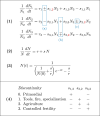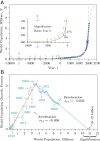Ecology of the Anthropocene signals hope for consciously managing the planetary ecosystem
- PMID: 34244429
- PMCID: PMC8285894
- DOI: 10.1073/pnas.2024150118
Ecology of the Anthropocene signals hope for consciously managing the planetary ecosystem
Abstract
Human populations have grown to such an extent that our species has become a dominant force on the planet, prompting geologists to begin applying the term Anthropocene to recognize the present moment. Many approaches seek to explain the past and future of human population growth, in the form of narratives and models. Some of the most influential models have parameters that cannot be precisely known but are estimated by expert opinion. Here we apply a unified model of ecology to provide a macroscale summary of the net effects of many microscale processes, using a minimal set of parameters that can be known. Our models match estimates of historic and prehistoric global human population numbers and provide predictions that correspond to some of the more complicated current models. In addition to fitting the data well they reveal that, amidst enormous complexity in our human and prehuman past, three key ecological discontinuities have occurred in turn: 1) becoming dominant competitors of large predators rather than their prey, 2) becoming mutualists with food species rather than acting as predators upon them, and 3) changing from a regime of uncontrolled population growth to one of controlled fertility instead. All three processes have been interlinked with cultural evolution and all three ushered in developments of the Anthropocene. Understanding the trajectories that have delivered us to this stage can help guide prudent paths into the future.
Keywords: anthropology; demographic transition; logistic and orthologistic growth; possibilist agenda; sustainability.
Copyright © 2021 the Author(s). Published by PNAS.
Conflict of interest statement
The authors declare no competing interest.
Figures




References
-
- Crutzen P. J., Geology of mankind. Nature 415, 23 (2002). - PubMed
-
- Ruddiman W. F., Ellis E. C., Kaplan J. O., Fuller D. Q.., Defining the epoch we live in. Is a formally designated Anthropocene a good idea? Science 348, 38–39 (2015). - PubMed
-
- Balter M., Archaeologists say the ‘Anthropocene’ is here—but it began long ago. Science 340, 261–262 (2013). - PubMed
-
- Lehman C., Loberg S., Clark A. T., Schmitter D., Unifying the basic models of ecology to be more complete and easier to teach. Bioscience 70, 415–426 (2020).
-
- Hutchinson G. E., An Introduction to Population Ecology (Yale University Press, New Haven, CT, 1978).
MeSH terms
LinkOut - more resources
Full Text Sources
Miscellaneous

